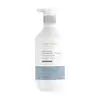What's inside
What's inside
 Benefits
Benefits

 Concerns
Concerns

No concerns
 Ingredients Side-by-side
Ingredients Side-by-side

Aloe Barbadensis Leaf Juice
Skin ConditioningCoco-Betaine
CleansingSodium Cocoyl Glycinate
CleansingLauryl Glucoside
CleansingPolyquaternium-10
Sclerocarya Birrea Seed Oil
HumectantArgania Spinosa Kernel Oil
EmollientVitis Vinifera Seed Oil
EmollientCetyl Alcohol
EmollientPhenoxyethanol
PreservativeSesamum Indicum Seed Oil
EmollientCarbomer
Emulsion StabilisingHydroxypropyl Guar
Emulsion StabilisingDisodium EDTA
Citric Acid
BufferingAloe Barbadensis Leaf Juice, Coco-Betaine, Sodium Cocoyl Glycinate, Lauryl Glucoside, Polyquaternium-10, Sclerocarya Birrea Seed Oil, Argania Spinosa Kernel Oil, Vitis Vinifera Seed Oil, Cetyl Alcohol, Phenoxyethanol, Sesamum Indicum Seed Oil, Carbomer, Hydroxypropyl Guar, Disodium EDTA, Citric Acid
Ingredients Explained
These ingredients are found in both products.
Ingredients higher up in an ingredient list are typically present in a larger amount.
Citric Acid is an alpha hydroxy acid (AHA) naturally found in citrus fruits like oranges, lemons, and limes.
Like other AHAs, citric acid can exfoliate skin by breaking down the bonds that hold dead skin cells together. This helps reveal smoother and brighter skin underneath.
However, this exfoliating effect only happens at high concentrations (20%) which can be hard to find in cosmetic products.
Due to this, citric acid is usually included in small amounts as a pH adjuster. This helps keep products slightly more acidic and compatible with skin's natural pH.
In skincare formulas, citric acid can:
While it can provide some skin benefits, research shows lactic acid and glycolic acid are generally more effective and less irritating exfoliants.
Most citric acid used in skincare today is made by fermenting sugars (usually from molasses). This synthetic version is identical to the natural citrus form but easier to stabilize and use in formulations.
Read more about some other popular AHA's here:
Learn more about Citric Acid